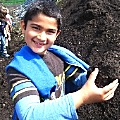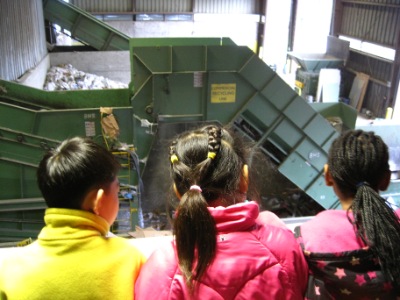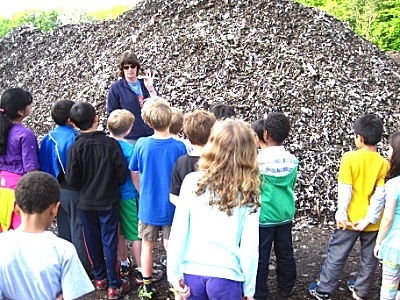- By Jeff Rubin
- Around Town
 Print
Print  Get ready, Northeast Elementary School—Caren Arnold's second-grade "environmental ambassadors" are out to change your habits.
Get ready, Northeast Elementary School—Caren Arnold's second-grade "environmental ambassadors" are out to change your habits."Everyone needs to recycle and compost if we're going to make the world a better place," says Finley Schindler, summing up his teacher's half-year effort to turn her class into advocates who can make a difference.
"We all produce waste—about four pounds a day—and we get to choose what we do with it," Arnold says: recycle it, compost it or send it to the landfill.
"If we keep up with what we're doing," says one of her students, Naya Ernste, "we're going to cover the whole world in garbage."
Thanks to a grant from the Ithaca Public Education Initiative (IPEI), Arnold purchased books for her classroom and took her students, along with Northeast's two other second-grade classes, on a pair of field trips that combined to make a big impression.

At Ithaca's Tompkins County Solid Waste facility, the students saw first-hand where trash and recycled materials go. Standing on a second-floor balcony in the massive sorting buiding, they watched as piles of newly-arrived materials were placed on the conveyer line, where machinery and workers sorted them into different containers.
In a nearby classroom, assistant recycling specialist Nancy Webster gave the kids some fine points of recycling. Spray cans, she explained, are recyclable as long as the product is for 'food or face' (whipped cream or sunscreen, for example) rather than something like insecticide or spray paint. Polystyrene, on the other hand, isn't recycled because it's uneconomical, being so light and bulky.
On a bright spring day one month later, the second-graders stood beside the newest of seven enormous windrows, or heaped-up rows, at Cayuga Compost's facility in Trumansburg.
The breeze carried a slight odor: not manure, but decay.
Right at their feet, co-owner Mary Proctor told the students, was compost material collected that morning from the Ithaca City School District, possibly even the remains of their very own lunches from the day before. Proctor pointed out foreign objects like glass, plastic, metal, styrofoam and milk cartons that had made their way into the compost and added that Ithaca students were doing better at sorting, but still had a way to go.
She introduced employee Thomas Rote, who was walking atop the windrow and picking out non-compostable contaminants for disposal.
Because Cayuga Compost's windrows are so huge—each is nearly 300 feet long, 20 feet wide and 9 feet high—their internal temperatures reach up to 170 degrees F. This allows materials like meat, dairy, fish, bones, fat, grease and shells to be included even though they can't be composted at home.
Proctor told the students that heavy equipment is used to "turn" the windrows every other day to give the micro-organisms inside enough oxygen to live and break down the organic matter.

The class walked past the ends of the windrows until they arrived at the result of 12 months' composting, a large pile of dark-brown screened humus—"last year's lunch," Proctor called it. She invited the kids to pick up handfuls to see and feel for themselves that it resembled nothing so much as plain old dirt. Nearby stood a pile of contaminants, including compostable utensils, which have proven not to be. Beginning Jan. 1, 2015, she said, Cayuga Compost will no longer accept them.
Now, back at school, Mrs. Arnold's students are ready to share what they've learned with their schoolmates.
Putting their math skills to work, they've made large graphs on bright orange paper showing how the four pounds of waste produced daily by the average American translate to 28 pounds each week and 120 pounds each month -- "as much as my Mom weighs," one boy shared excitedly.
The class is also working to create an informational video on how to improve recycling and composting efforts at Northeast. It may include their own creative ideas on how to reduce waste, including not using straws and bringing reusable containers to restaurants to take home their leftovers.
v10i21



